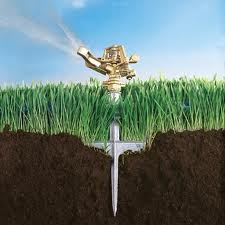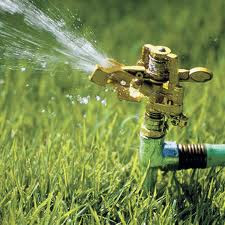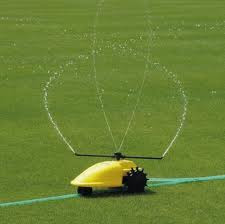Some questions you might ask yourself are "What are Pulsating Sprinklers?" and, "Should I be using pulsating sprinklers for my lawn?"
If you don't have or don't want to use an underground automatic sprinkler system, hose faucet watering is an excellent alternative. Hose faucet watering is done with a hose and one or several pulsating sprinklers.
A very basic and broad definition of Pulsating Sprinklers is any sprinkler that is not underground and functions independently of other sprinklers.
To give a better idea of the purpose of pulsating sprinklers, what they are, and how they work, let's identify the different types of pulsating sprinklers.
Types of Pulsating Sprinklers
There are 5 types of Pulsating Sprinklers- Stationary
- Oscillating
- Impulse
- Rotary
- Traveling
- Layout and structure of your lawn and yard
- Budget
- Water Pressure
1. Stationary Pulsating Sprinklers
The first type of pulsating sprinklers is Stationary.Since "stationary" means not moving or not intended to be moved, a Stationary Pulsating Sprinkler either sits on a spike or spiked base.
- Pros:
- Work well with most lawn layouts and structures
- They are not very expensive
- Cons:
- Because they are not intended to be manually moved or re positioned, Stationary Pulsating Sprinklers require high water pressure.
- Only cover an 85 foot diameter. This might be more than enough for some, but if you have a large lawn, you will probably have to buy multiple Stationary sprinklers in order to get all the coverage your lawn requires.
- Example: The Orbit Metal Impact Sprinkler on Spike Base
2. Oscillating Pulsating Sprinklers
Probably the most common type of Pulsating Sprinklers are Oscillating Sprinklers. I'm sure you've seen them. They lay flat on the ground and shoot water high up in the air as the nozzles turn round and round.While most of the other Pulsating Sprinkler types literally pulse, the oscillating sprinklers disperse water at a more consistent and even-flowing rate of speed.
- Pros:
- Work well with most lawn layouts and structures
- They are not very expensive
- There are many different kinds to choose from. Some with less than 60 holes, and some with more than 100 for more water deliverance
- Because they lay flat on the ground, Oscillating sprinklers can be moved from area to area so you don't necessarily need a lot of water pressure
- Some Oscillating Sprinklers cover up to 3600 square feet! So there is no need for more than one (unless you want to water your front and back yard at the same time)
- Cons:
- The Oscillating sprinklers will shoot water high up into the sky, so overhanging decor, tree branches, and the like are at risk of getting wet.
- Example: The Orbit 91718
3. Impulse Pulsating Sprinklers
Impulse pulsating sprinklers are extremely efficient and versatile because they operate on low water pressure and discharge more water over larger areas than other sprinklers. Their spray is powerful and close to the ground which makes them wind resistant.If you have ever seen someone do "The Sprinkler" at a dance party, they're imitating an Impulse Pulsating Sprinkler because of the way the jig they do as they shimmy from side to side.
Impulse Pulsating Sprinklers are almost always Stationary.
- Pros:
- Work well with most lawn layouts and structures
- They are not very expensive
- Wind-Resistant
- The large orifice prevents clogging, unlike oscillator holes.
- Durable - Most are made of steel, brass, or zinc
- Full-Circle Operation
- Cons:
- After long periods of time, some impulse sprinklers have been known to rust.
- Example: The Orbit 55032 Brass Impact Sprinkler Head
4. Rotary Pulsating Sprinklers
Technically, Rotary Pulsating Sprinklers can include some Impulse and Stationary Sprinklers but the most common rotary sprinklers have three arms and spin as the water pressure surges through. Basically, any sprinkler that allows for Full-Circle spray coverage is considered a Rotary Impulse Sprinkler.When using a garden hose for lawn watering, most people like to turn on their hose, set a sprinkler out in the middle of the lawn, and let the sprinkler water a section of the lawn for 15 minutes or so. Rotary sprinklers make that possible because they can cover a good amount of space before or without being moved or re positioned.
- Pros:
- Work well with most lawn layouts and structures
- They are not very expensive - Wal Mart has cheap plastic ones that work well for less than 5 dollars
- Durable - more expensive ones are made of steel, brass, or zinc
- Full-Circle Operation
- Cons:
- the small holes can become clogged
- most can only cover an area of 50 feet or less
- Example: The Orbit Rotary Sprinkler
5. Traveling Pulsating Sprinklers
Traveling Pulsating Sprinklers are self propelled devices that spray as they roll. Traveling as much as 200 feet, these sprinklers act as Rotary sprinklers except they move themselves so you don't have too.Some Traveling sprinklers are smarter than others, capable of being programmed to go certain distances, lengths, and speeds.
- Pros:
- Durable
- Full-Circle Operation
- You don't have to worry about getting up and re positioning it
- Cons:
- the small holes can become clogged
- work best with simple lawn layouts
- Generally more expensive than other Pulsating Sprinklers
- Example: The Orbit Traveling Sprinkler
I hope this helped you learn about the different types of pulsating sprinklers and to determine which, if any, is the best choice for you and your lawn.






No comments:
Post a Comment